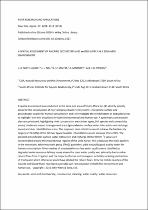 ResearchSpace
ResearchSpace
A spatial assessment of riverine ecosystems and water supply in a semi-arid environment
JavaScript is disabled for your browser. Some features of this site may not work without it.
- ResearchSpace
- →
- Research Publications/Outputs
- →
- Journal Articles
- →
- View Item
| dc.contributor.author |
Smith-Adao, Lindie B

|
|
| dc.contributor.author |
Nel, JL

|
|
| dc.contributor.author |
Le Maitre, David C

|
|
| dc.contributor.author |
Maherry, A

|
|
| dc.contributor.author |
Swartz, ER

|
|
| dc.date.accessioned | 2012-02-24T11:14:14Z | |
| dc.date.available | 2012-02-24T11:14:14Z | |
| dc.date.issued | 2011-12 | |
| dc.identifier.citation | Smith-Adao, LB, Nel, JL, Le Maitre, D.C., Maherry, A and Swartz, ER. 2011. A spatial assessment of riverine ecosystems and water supply in a semi-arid environment. River Research and Applications, vol. 27(10), pp 1298–1314 | en_US |
| dc.identifier.issn | 1535-1459 | |
| dc.identifier.uri | http://onlinelibrary.wiley.com/doi/10.1002/rra.1427/pdf | |
| dc.identifier.uri | http://hdl.handle.net/10204/5598 | |
| dc.description | Copyright: 2011 Wiley | en_US |
| dc.description.abstract | A spatial assessment was conducted in the semi-arid area of South Africa, to: (1) identify priority areas for the conservation of river and groundwater ecosystems; (2) examine surface and groundwater quality for human consumption and (3) investigate the rehabilitation of degraded areas to highlight ‘win-win’ situations for both environmental and human use. A systematic conservation plan was produced, highlighting river conservation areas (river types, fish species and connectivity areas), moderate-impact management areas (groundwater-surface water interaction and recharge areas) and river rehabilitation areas. The proposed river selections would achieve the biodiversity targets of 33 (66%) of the 50 river types; feasible rehabilitation would increase this to 92%. The greatest groundwater-surface water interaction and recharge (30 to>50mm -1) values are concentrated around the mountainous regions of the Little Karoo. This is because the main aquifers in the mountains, table mountain group (TMG) quartzites, yield naturally good quality water for human consumption. River reaches of unacceptable surface water quality were classified as degraded water resource delivery areas where the poor water quality was primarily due to saline return flows from irrigation and the impacts of other anthropogenic activities including abstraction of freshwater which otherwise would have diluted the return flows. Only the middle reaches of the Gouritz and Groot Rivers represent a possible win–win situation for both the environment and human use. | en_US |
| dc.language.iso | en | en_US |
| dc.publisher | Wiley | en_US |
| dc.relation.ispartofseries | Workflow;8169 | |
| dc.subject | Semi-arid | en_US |
| dc.subject | Conservation planning | en_US |
| dc.subject | Water quality | en_US |
| dc.subject | Biodiversity | en_US |
| dc.subject | Water resources | en_US |
| dc.title | A spatial assessment of riverine ecosystems and water supply in a semi-arid environment | en_US |
| dc.type | Article | en_US |
| dc.identifier.apacitation | Smith-Adao, L., Nel, J., Le Maitre, D. C., Maherry, A., & Swartz, E. (2011). A spatial assessment of riverine ecosystems and water supply in a semi-arid environment. http://hdl.handle.net/10204/5598 | en_ZA |
| dc.identifier.chicagocitation | Smith-Adao, LB, JL Nel, David C Le Maitre, A Maherry, and ER Swartz "A spatial assessment of riverine ecosystems and water supply in a semi-arid environment." (2011) http://hdl.handle.net/10204/5598 | en_ZA |
| dc.identifier.vancouvercitation | Smith-Adao L, Nel J, Le Maitre DC, Maherry A, Swartz E. A spatial assessment of riverine ecosystems and water supply in a semi-arid environment. 2011; http://hdl.handle.net/10204/5598. | en_ZA |
| dc.identifier.ris | TY - Article AU - Smith-Adao, LB AU - Nel, JL AU - Le Maitre, David C AU - Maherry, A AU - Swartz, ER AB - A spatial assessment was conducted in the semi-arid area of South Africa, to: (1) identify priority areas for the conservation of river and groundwater ecosystems; (2) examine surface and groundwater quality for human consumption and (3) investigate the rehabilitation of degraded areas to highlight ‘win-win’ situations for both environmental and human use. A systematic conservation plan was produced, highlighting river conservation areas (river types, fish species and connectivity areas), moderate-impact management areas (groundwater-surface water interaction and recharge areas) and river rehabilitation areas. The proposed river selections would achieve the biodiversity targets of 33 (66%) of the 50 river types; feasible rehabilitation would increase this to 92%. The greatest groundwater-surface water interaction and recharge (30 to>50mm -1) values are concentrated around the mountainous regions of the Little Karoo. This is because the main aquifers in the mountains, table mountain group (TMG) quartzites, yield naturally good quality water for human consumption. River reaches of unacceptable surface water quality were classified as degraded water resource delivery areas where the poor water quality was primarily due to saline return flows from irrigation and the impacts of other anthropogenic activities including abstraction of freshwater which otherwise would have diluted the return flows. Only the middle reaches of the Gouritz and Groot Rivers represent a possible win–win situation for both the environment and human use. DA - 2011-12 DB - ResearchSpace DP - CSIR KW - Semi-arid KW - Conservation planning KW - Water quality KW - Biodiversity KW - Water resources LK - https://researchspace.csir.co.za PY - 2011 SM - 1535-1459 T1 - A spatial assessment of riverine ecosystems and water supply in a semi-arid environment TI - A spatial assessment of riverine ecosystems and water supply in a semi-arid environment UR - http://hdl.handle.net/10204/5598 ER - | en_ZA |





